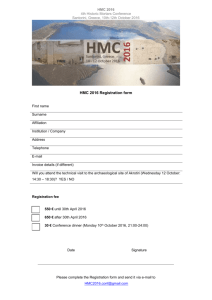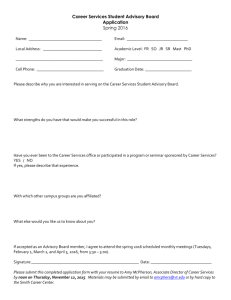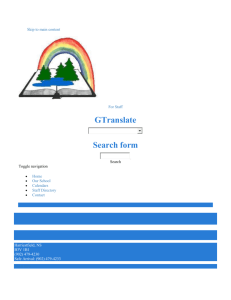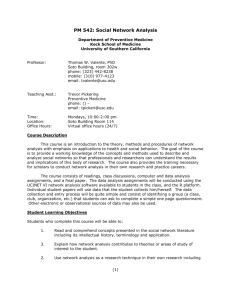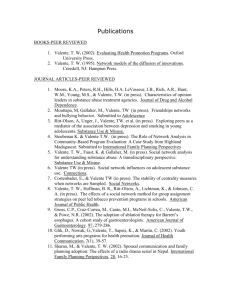syllabus - Pages - University of Wisconsin
advertisement
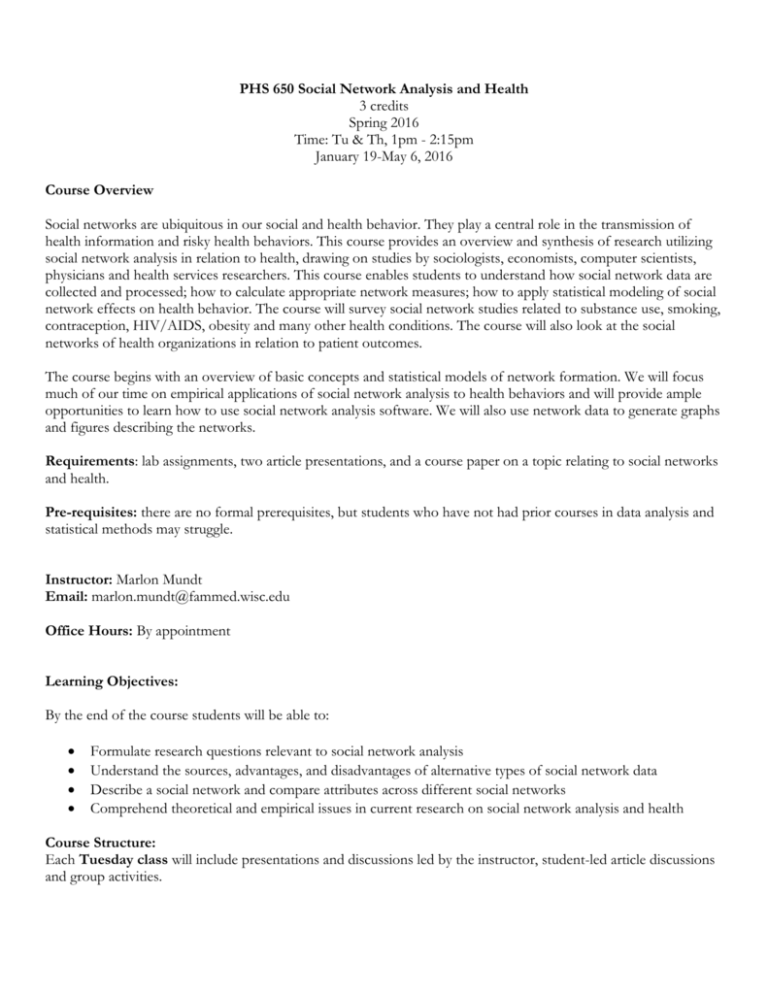
PHS 650 Social Network Analysis and Health 3 credits Spring 2016 Time: Tu & Th, 1pm - 2:15pm January 19-May 6, 2016 Course Overview Social networks are ubiquitous in our social and health behavior. They play a central role in the transmission of health information and risky health behaviors. This course provides an overview and synthesis of research utilizing social network analysis in relation to health, drawing on studies by sociologists, economists, computer scientists, physicians and health services researchers. This course enables students to understand how social network data are collected and processed; how to calculate appropriate network measures; how to apply statistical modeling of social network effects on health behavior. The course will survey social network studies related to substance use, smoking, contraception, HIV/AIDS, obesity and many other health conditions. The course will also look at the social networks of health organizations in relation to patient outcomes. The course begins with an overview of basic concepts and statistical models of network formation. We will focus much of our time on empirical applications of social network analysis to health behaviors and will provide ample opportunities to learn how to use social network analysis software. We will also use network data to generate graphs and figures describing the networks. Requirements: lab assignments, two article presentations, and a course paper on a topic relating to social networks and health. Pre-requisites: there are no formal prerequisites, but students who have not had prior courses in data analysis and statistical methods may struggle. Instructor: Marlon Mundt Email: marlon.mundt@fammed.wisc.edu Office Hours: By appointment Learning Objectives: By the end of the course students will be able to: Formulate research questions relevant to social network analysis Understand the sources, advantages, and disadvantages of alternative types of social network data Describe a social network and compare attributes across different social networks Comprehend theoretical and empirical issues in current research on social network analysis and health Course Structure: Each Tuesday class will include presentations and discussions led by the instructor, student-led article discussions and group activities. Each Thursday lab will include hands on opportunities to use social network software. Multiple SNA software packages will be introduced and explained. Course Materials: Lab Assignments: There will be lab assignments that students will work with in the lab and at home. Labs must be completed by the due date in order to receive full credit. If a student misses a deadline, they may complete it before the end of the course for half credit. Videos: Videos of the lab instructions will be posted on the course web page to assist with the lab assignments. Class Software: UCINET, free 90-day trial available at https://sites.google.com/site/ucinetsoftware/home Various packages in R (RSIENA, STATNET, etc) free Grading and Assessments: The grading scale for the course will be: A: 90-100, AB: 85-89, B: 80-84, BC: 74-79, C: 69-73, D: 64-68, F: 63 or below Assignments: 1. Class participation (10%) Students are required to attend each class prepared to discuss the assigned readings. 2. Lab Assignments (30%) The course will include lab assignments, where each student will manipulate social network analysis software using provided data. 3. Student Paper Discussion Presentation (20%) Each student will make a short presentation and lead discussion on two social network papers, discussing the research question, the data, the empirical approach, the limitations, and key findings. 4. Class Paper (40%) Each student will prepare a class paper that either (1) surveys a specific part of the health literature on social networks or (2) outlines a potential research project on social networks, discussing data, empirical approach and main hypothesis which may serve as a draft for a future R21 grant submission. There are two key deliverables for the class project. One is a 15-minute PowerPoint presentation in the last days of classes. Creativity and clarity is encouraged in the presentation. The other is a 10+ page (double- spaced, 12-point, 1-inch margins) written report due a few days after the presentation. The grade for the research project will be an average of the two deliverables. The textbook for the course is: Valente, T. W. (2010). Social Networks and Health: Models, Methods, and Applications. Oxford University Press: Oxford, UK. Recommended: Wasserman, S. & Faust, K. (1994). Social network analysis: Methods and applications. New York: Cambridge University Press. Hanneman, R. A. & Riddle, M. (2005). Introduction to social network methods. Riverside, CA: University of California, Riverside (published in digital form at http://faculty.ucr.edu/~hanneman/nettext/Introduction_to_Social_Network_Methods.pdf) THE ONLY BOOK FOR YOU TO PURCHASE IS VALENTE (2010) Course datasets Datasets for lab assignments will be made available on the course website. Additional Datasets online http://konect.uni-koblenz.de/networks/moreno_health Course Schedule and Readings Week 1 (Jan 19, 2016) Introduction, theoretical and empirical background Required Reading: Valente, Ch. 1,2 Luke, D. A., & Harris, J. K. (2007). Network analysis in public health: History, methods, and applications. Annual Review of Public Health, 28, 69-93. Watts, D. J. (2004). The “New” science of networks. Annual Review of Sociology, 30, 243-70. Recommended: Huisman, M., & van Duijn, M.A.J. (2011). A reader’s guide to SNA software. In J. Scott & P. J. Carrington (Eds.), The SAGE handbook of social network analysis (pp. 578-600). Sage Publications. Lab 1: SNA software introduced. Tour of UCINET. Week 2 (Jan 26, 2016) Network fundamentals, terminology, network representations, types of network data Required reading: Valente, Ch. 3 Barabasi, A-L. (2007). Network medicine-From obesity to the “Diseasome.” NEJM, 357, 404- 407 Christakis, N. A., & Fowler, J. H. (2007). The spread of obesity in a large social network over 32 years. The New England Journal of Medicine, 357, 370-379. Cohen-Cole, E., & Fletcher, J. M. (2008). Detecting implausible social network effects in acne, height and headaches: longitudinal analysis. BMJ, 337, a2533. Watch before class: TED talks Nicholas Christakis: The hidden influence of social networks http://www.ted.com/talks/nicholas_christakis_the_hidden_influence_of_social_networks Recommended: Hanneman, Chapter 1, 8-10 Krempel, L. (2011). Network visualization. In J. Scott & P. J. Carrington (Eds.), The SAGE handbook of social network analysis (pp. 558-577). Sage Publications. Lab 2: Displaying Networks. Week 3 (Feb 2, 2016) SNA instrument development, data collection, data management, basic ways to describe networks Required: Valente, Ch. 4. Kossinets, G. (2006). Effects of missing data in social networks. Social Networks, 28, 247-268. Marsden, P. V. (1990). Network data and measurement. Annual Review of Sociology, 16, 435- 463. Marsden, P. V. (2011). Survey methods for network data. In J. Scott & P. J. Carrington (Eds.), The SAGE handbook of social network analysis (pp. 370-388). Sage Publications. Klovdahl, A. S. (1989). Urban social networks: Some methodological problems and possibilities. In Kochen, M (Ed.) The small world. Norwood, NJ: Ablex. Recommended: Hawe, P., Webster, C., & Shiell, A. (2004). A glossary of terms for navigating the field of social network analysis. Journal of Epidemiology & Community Health, 58, 971-975. Marin, A., & Wellman, B. (2011). Social network analysis: An introduction. In J. Scott & P. J. Carrington (Eds.), The SAGE handbook of social network analysis (pp. 11-25). Sage Publications. Game to try before class: http://oracleofbacon.org// Lab 3: Basic triadic and cohesion measures. Week 4 (Feb 9) Network prominence; Positional analysis: centrality, prestige Required: Valente, Ch. 5 & 7 Burt, R. S. (2004). Structural holes and good ideas. American Journal of Sociology. 110(2): 349-399. Freeman, L. C. (1979). Centrality in social networks: Conceptual clarification. Soc Networks, 1(3):215-239. Borgatti, S. P. (2005). Centrality and network flow. Soc Networks, 27:55-71. Class Activity “Network-at-Play” Recommended: Bell, D. C., Atkinson, J. S., Carlson, J. W. (1999). Centrality measures for disease transmission networks. Soc Networks. 21:1-21. Butts, C. T. (2008). Social network analysis with sna. Journal of Statistical Software, 24. Available online at www.jstatsoft.org. Lab 4: Interpreting network graphs. Exporting network images. Week 5 (Feb 16, 2016) Groups and subgroups Required: Valente Ch. 6. Newman, M.E.J. (2004). Detecting community structure in networks. Eur Phys J B. 38:321- 330. Newman, M.E.J. (2006). Modularity and community structure in networks. PNAS, 103:8577- 8582. Gest, S. D., Moody, J., & Rulison, K. L. (2007). Density or distinction? The roles of data structure and group detection methods in describing adolescent peer groups. Journal of Social Structure, 8(1). Recommended: Wasserman and Faust, Chapter 9-10 Hanneman, Chapters 4-6, 18 Scott, J. (2000). Components, Cores and Cliques. Chapter 6 in Social Network Analysis: A Handbook. London: Sage Publications. Blondel, V. D., Guillaume, J-L., Lambiotte, R., & Lefebvre, E. (2008). Fast unfolding of communities in large networks. Journal of Statistical Mechanics: Theory and Experiment, P10008. Lab 5: Clusters, Factions and Cores. SNA packages in R introduced. (Feb 23) One-on-one meetings about the course paper. Week 6 (March 1) Testing hypothesis about networks: Random graph models Required: Valente, Ch. 9 McPherson, M., Smith-Lovin, L., & Cook, J. M. (2001). Birds of a feather: Homophily in social networks. Annu Rev Sociol. 27: 415-444. Kossinets, G. & Watts, D.J. (2009). Origins of homophily in an evolving social network. American Journal of Sociology, 115(2)405-450. Luke, D. A., Harris, J. K., Shelton, S., Allen, P., Carothers, B. J., & Mueller, N. B. (2010). Systems analysis of collaboration in 5 national tobacco control networks. American Journal of Public Health, 100, 1290-1297. doi:10.2105/APH.2009.184358. Morris, M., Handcock, M. S., & Hunter, D. R. (2008). Specification of exponential-family random graph models: Terms and computational aspects. Journal of Statistical Software, 24(4). Recommended: Goodreau, S. M., Handcock, M. S., Hunter, D. R., Butts, C. T., & Morris, M. (2008). A statnet tutorial. Journal of Statistical Software, 24, 1-26. Available at: www.jstatsoft.org. Goodreau, S. M. (2007). Advances in exponential random graph (p*) models applied to a large social network. Soc Networks, 29, 231-248. O’Malley, J., Marsden, P. V. (2008). The analysis of social networks. Health Services and Outcomes Research Methodology, 8, 222-269. Watch video before class: The NIH Office of Behavioral and Social Sciences Research and CDC's Syndemics Prevention Network Spring 2007 symposia series on Systems Science and Health http://videocast.nih.gov/podcast/ss/ss061207/ss061207.m4v Lab 6: Exponential Random Graph Models. Week 7 (March 8) Testing hypothesis about networks: Stochastic actor-based modeling Required: Valente, Ch.12 Aral, S., Muchnik, L., & Sundararaja, A. (2009). Distinguishing influence-based contagion from homophily-driven diffusion in dynamic networks. PNAS 106(51): 21544-21549. Snijders TAB, van de Bunt G, Steglich C (2010). Introduction to stochastic actor-based models for network dynamics. Soc Networks. 32:44-60. Dishion TJ (2013). Stochastic agent-based modeling of influence and selection in adolescence: Current status and future directions in understanding the dynamics of peer contagion. J Res Adol. 23(3):596-603. Recommended: Snijders TAB (1996). Stochastic actor-oriented models for network change. J Math Soc. 21:149-172. Manski, C.F. (1993): Identification of endogenous social effects: The reflection problem. Review of Economic Studies, 60:531-542. Shalizi, C. R. & Thomas, A. C. (2011). “Homophily and contagion are generically confounded in observational social network studies.” Sociological Methods & Research 40(2): 211–239. Lab 7: SIENA package in R: Introduction. Week 8 (March 15) SNA application: Flows and diffusion. Required: Valente, Ch. 10-11 Wipfli, H. L., Fujimoto, K., & Valente, T. W. (2010). Global tobacco control diffusion: The case of the Framework Convention on Tobacco Control. AJPH, 100, 1260-1266. White, H. D., Wellman, B., & Nazer, N. (2004). Does citation reflect social structure? Longitudinal evidence from the “Globenet” interdisciplinary research group. Journal of the American Society for Information Science and Technology, 55, 111-126. Klovdahl, A.S., Gravis, E.A., Yaganehdoost, A., Ross, M.W., Wanger, A., Adams, G.J., Musser, J.M. (2001). Networks and tuberculosis: An undetected community outbreak involving public places. Soc Sci Med. 38:79-88. Recommended: Hummon, N. P., & Doreian, P. (1989). Connectivity in a citation network: The development of DNA Theory. Soc Networks, 11, 39-63. Watch before class: Diffusion of Innovations by Dr. Tom Valente https://www.youtube.com/watch?v=ZG9dAIBd4xQ https://www.youtube.com/watch?v=mVVGGTe2bJM https://www.youtube.com/watch?v=ZG9dAIBd4xQ Lab 8: Selection and influence. Spring Break: ( March 22, 2016) Week 9 (March 29, 2016) SNA application: Social networks and substance use Required: Valente, T. W., Mouttapa, M. & Gallaher, M. (2004). Social network analysis for understanding substance abuse: A transdisciplinary perspective. Substance Use & Misuse, 39:1685-1712. Light, JM., Greenan, CC., Rusby, JC., Nies, KM., Snijders, TAB. (2013) Onset to first alcohol use in early adolescence: A network diffusion model. J Res Adol, 23(3):487-499. Osgood, D. W., Ragan, D. T., Wallace, L., Gest, S. D., Feinberg, M. E., Moody, J. (2013). Peers and the emergence of alcohol use: Influence and selection processes in adolescent friendship networks. J Res Adol. 23(3):500-512. Mathys, C., Burk, W. J., & Cillessen, A. H. N. (2013). Popularity as a moderator of peer selection and socialization of adolescent alcohol, marijuana, and tobacco use. J Res Adol. 23(3):513-523. Recommended: Knecht, A.B., Burk, W.J., Weesie, J., Steglich, C.E.G. (2010). Friendship and alcohol use in early adolescence: A multilevel social network approach. J Res Adolesc. 21:475-487. Burk, W.J., Van der Vorst, H., Kerr, M., Stattin, H. (2012). Alcohol use and friendship dynamics: Selection and socialization in early-, middle-, and late-adolescent peer networks. J Stud Alc Drugs. 73:89-98. Mundt, M.P., Mercken, L., Zakletskaia, L. (2012). Peer selection and influence effects on adolescent alcohol use: A stochastic actor-based model. BMC Pediatrics, 12:115. Lab 9: Visualizing social network dynamics. Week 10 (April 5, 2016) SNA application: Social networks and smoking Required: Mercken, L.,Sleddens, E.F.C., de Vries, H., Steglich, C.E.G. (2013). Choosing adolescent smokers as friends: The role of parenting and parental smoking. Journal of Adolescence. 1-10. Valente, T.W., Unger, J., & Johnson, A. C. (2005). Do popular students smoke? The association between popularity and smoking among middle school students. Journal of Adolescent Health, 37:323-329. Fletcher, J. M. (2010). Social interactions and smoking: Evidence using multiple student cohorts, instrumental variables, and school fixed effects. Health Economics, 19(4):466-484. Roberts, M.E., Nargiso, J.E., Gaitonde, L.B., Stanton, C.A., Colby, S.M. (2015). Adolescent social networks: General and smoking-specific characteristics associated with smoking. J Stud Alcohol Drugs. 76:247–255. Recommended: Harris, J. K., Luke, D. A., Zuckerman, R., & Shelton, S. C. (2009). Forty years of secondhand smoke research: The gap between discovery and delivery. AJPM, 36, 538-548. Mercken, L., Candel, M., Willems, P., & De Vries, H. (2007). Disentangling social selection and social influence effects on adolescent smoking: the importance of reciprocity in friendships. Addiction, 102(9):1483-1492. Mercken, L., Steglich, C.E.G, Sinclair, P., Holliday, J., & Moore, L. (2012). A longitudinal social network analysis of peer influence, peer selection, and smoking behavior among adolescents in British schools. Health Psychology, 31(4):450-459. Lab 10: Centralities and their interpretation. Week 11 (April 12, 2016) SNA application: Sexual networks, HIV and epidemics Required: Bearman, P.S., Moody, J.M., & Stovel, K. (2004). Chains of affection: The structure of adolescent romantic and sexual networks. American Journal of Sociology, 110(1):44-91 Backstrom, L. & Kleinberg, J. (2014). Romantic partnerships and the dispersion of social ties: A network analysis of relationship status on Facebook. Proc 17th ACM CSCW. 2014: 831-841. Friedman SR, Neiagus A, Jose B, et al. (1997). Sociometric risk networks and risk for HIV infection. AJPH. 87:1289-1296. Oster, A.M., Wejnert, C., Mena, L.A., Elmore, K., Fisher, H., & Heffelfinger, J.D. (2013). Network analysis among HIV-infected young black men who have sex with men demonstrates high connectedness around few venues. Sex Transm Dis. 40(3):206-212. Christakis, N. A. & Fowler, J. H. (2010). Social network sensors for early detection of contagious outbreaks. PLoS ONE 5(9). Recommended: Helleringer S. & Kohler, H.P. (2007). Sexual network structure and the spread of HIV in Africa: evidence from Likoma Island, Malawi. AIDS, 21:2323-2332. Little , S.J., Kosakovsky Pond, S.L., Anderson, C.M., et al. (2014). Using HIV networks to inform real time prevention interventions. PLoS ONE 9(6). Watch before class: Nicholas Christakis: How social networks predict epidemics http://www.ted.com/talks/nicholas_christakis_how_social_networks_predict_epidemics Lab 11: Closeness and betweenness. Week 12 (April 19, 2016) SNA application: Social networks in health organizations Required: Tasselli S. (2014). Social networks of professionals in health care organizations: A review. Med Care Res Rev. 71(6):619-660. Chambers, D., Wilson, P., Thompson, C., & Harden, M. (2012). Social network analysis in healthcare settings: A systematic scoping review. PLoS ONE 7(8). Scott J., Tallia A., Crosson J.C., Orzano A.J., Stroebel C., DiCicco-Bloom B., O'Malley D., Shaw E., Crabtree B. (2005). Social network analysis as an analytic tool for interaction patterns in primary care practices. Ann Fam Med. 3(5):443-448. Nair H.S., Manchanda P., Bhatia T. (2010). Asymmetric social interactions in physician prescription behavior: the role of opinion leaders. Journal of Marketing Research 47(5): 883–895. Latkin C.A., Knowlton A.R. (2015). Social network assessments and interventions for health behavior change: A critical review. Behavioral Medicine 41: 90–97. Recommended: Borgatti, S. P., & Halgin, D. S. (2011). Analyzing affiliation networks. In J. Scott & P. J. Carrington (Eds.), The SAGE handbook of social network analysis (pp. 417-433). Sage Publications Mundt M.P., Gilchrist V.J., Fleming M.F., Zakletskaia L.I., Tuan W.J., Beasley J.W. (2015). Effects of primary care team social networks on quality of care and costs for patients with cardiovascular disease. Ann Fam Med. 13(2):139-148. Lab 12: Affiliation networks and network mobility. Week 13 (April 26, 2016) Student presentations Week 14 (May 3, 2016) Student presentations Policy on Absence Attendance and participation in the course counts for 10% of the grade. Missing class or failing to participate will negatively impact a student’s grade. Emergencies and excused absences will be handled on a case by case basis by the course instructor. Unexcused absence from class will result in points lost from attendance and participation for the week. COURSE ENVIRONMENT AND ACADEMIC INTEGRITY/MISCONDUCT Students are encouraged to discuss course material and content with each other. However, unless otherwise indicated, assignments and quizzes should be representative of their own work. Please refer to this website on student misconduct: http://www.wisc.edu/students/saja/misconduct/misconduct.html Policy on Non-Discrimination The UW–Madison is committed to creating a dynamic, diverse and welcoming learning environment for all students and has a non-discrimination policy that reflects this philosophy. Disrespectful behaviors or comments addressed towards any group or individual, regardless of race/ethnicity, sexuality, gender, religion, ability, or any other difference is deemed unacceptable in this class. Policy on Special Needs or Disabilities I wish to fully include persons with special needs or disabilities in this course. Please let the instructor know if you need any special accommodations in the curriculum, instruction, or assessments of this course to enable you to fully participate. Civility Policy Members of the University of Wisconsin-Madison community are expected to deal with each other with respect and consideration. The civility policy for this course promotes mutual respect, civility and orderly conduct among the faculty, teaching assistants, and students. We do not intend this policy to deprive any person of his or her right to freedom of expression. Rather, we seek to maintain a safe, harassment-free work-place for the students, faculty, and teaching assistants. Positive communication is encouraged and volatile, hostile, or aggressive actions and language will not be tolerated. If the civility policy for this course is violated, then the individual is subject to removal from the class and possibly the course altogether. In addition, the proper authorities at the UW Departmental, School, and University levels will be notified of such behavior accordingly and further action may be taken if necessary.






